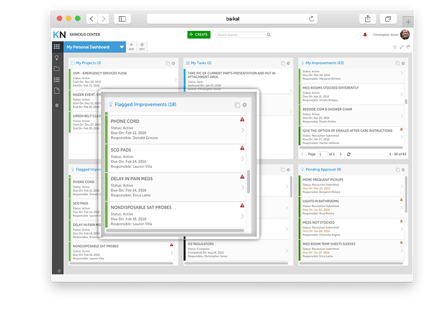
Each customer who comes to us has a unique set of challenges and goals. Each will implement our solution in a different way that fits their needs, but there are some common reasons that they've decided to invest in improvement management software.
Here are the top 10 most common reasons:
1. It Brings Structure to Improvement Work
Many organizations use improvement techniques and tools, like Standard Work, PDSA, A3, and others, to support improvement activities. Continuous improvement software is a platform for managing those tools and making them more useful. Every team member has one place to go to document improvement efforts, accept and make assignments, and communicate about every open project.
2. Employees Can Submit Opportunities without Friction
Most of the leaders we talk to believe that everyone can contribute valuable opportunities for improvement but without a standard solution for capturing them, ideas can be forgotten or unregistered. Improvement software makes it easy for every employee to submit an idea for innovation on any device from wherever they happen to be.
3. A Shared Language is Formed
The way we describe our improvement work is an integral part of the culture. When you have a common language to describe improvement work, you can avoid confusion and misunderstanding. With improvement management software in place, people use the solution as a baseline for communication, and a common vocabulary starts to emerge.
4. Executive Commitment is Apparent
People know that money is invested in aspects of the business that are important to leaders. These days, almost every business function has software to support it. By implementing a platform for managing innovation, you signal to the organization that improvement work is just as crucial as accounting or inventory management.
5. Employee Engagement Increases
One of the most significant drawbacks of managing improvement work in spreadsheets is that they are passive. Someone has to think to open up the spreadsheet and take action. What’s great about improvement software is that it has built-in alerts and notifications to make people aware when action is required. Managers are notified when a new idea needs review. Team members know when tasks are due or when deadlines are missed. When improvement work is front and center, engagement improves.
6. Collective Wisdom Grows
CI software forms a repository of knowledge for the organization. Because each project is thoroughly documented, the benefits of what is learned lasts long beyond any individual initiative. Things that work well can be repeated, and mistakes can be avoided. Ideally, one team can learn from the experiences of another, and each effort gets smarter and smarter.
7. The Health of Improvement Culture is Measured
Measuring culture may seem impossible but with the right solution, you can take the vital signs of your organization when it comes to improvement. How many people are contributing ideas? How many projects are ongoing? Are there departments or teams that are thriving or struggling? Improvement software answers these questions and many more.
8. Strategic Goals and Individual Objectives are Aligned
Improvement work doesn’t happen in a vacuum. It should be in line with the most important strategic goals and objectives of the organization. This means that each person must understand how their goals and initiatives relate to the overall corporate aims and direction. With the right improvement management technology, you can cascade goals down from the executive suite to the individual front-line worker.
9. Impact is Measured
It is difficult to overstate the importance of measuring and reporting the results of improvement activities. It’s the end results that get both workers and leaders excited about efforts to implement positive change. Improvement technology makes it easy to report results in terms that matter to the business, such as cost savings, revenue, customer satisfaction, quality, and the like. Employees are delighted when they can see their efforts paying off in ways that can be proven.
10. Success is Recognized
The best way to keep people excited about continuous improvement is to recognize and reward each accomplishment. The best improvement management technology has a feature called success broadcasting. Letting the entire organization know when an objective has been achieved is an excellent way to sustain momentum and spread enthusiasm.
These are the compelling reasons why leaders invest in continuous improvement technology despite tight budgets. The payback is substantial.




Add a Comment